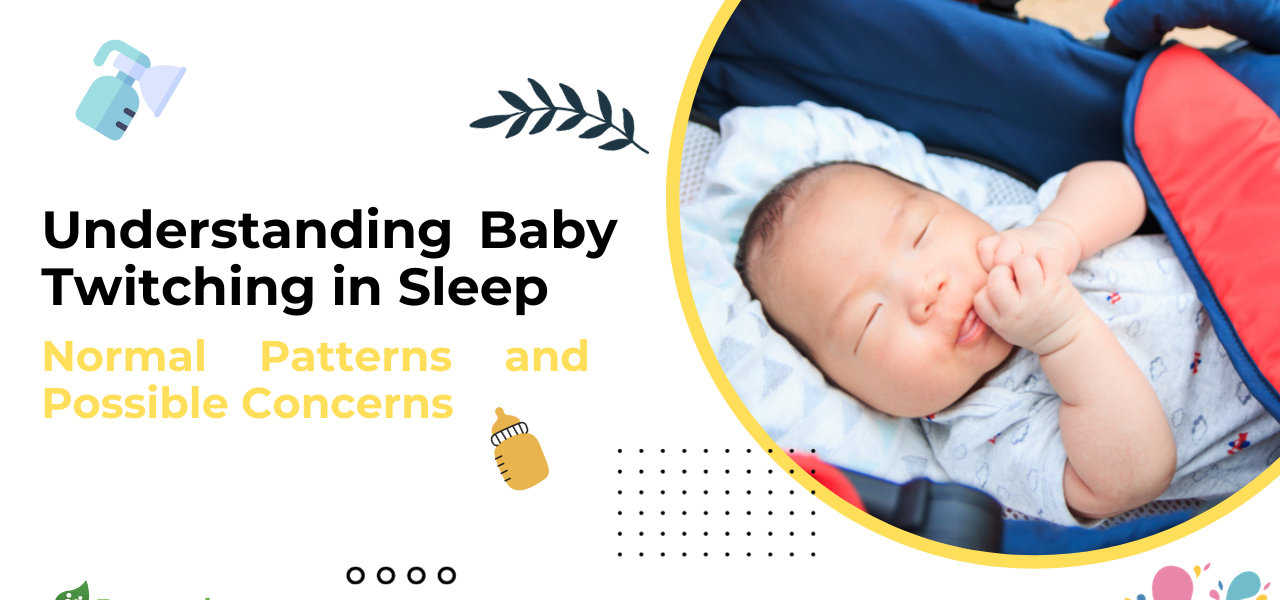Watching your baby sleep is a mesmerizing experience, but observing them twitch or jerk can sometimes raise concerns for parents. Understanding the nuances of baby movements during sleep and baby twitching in sleep is crucial in deciphering between typical patterns and potential issues.
Is Baby Twitching in Sleep Normal?
Twitching or jerking movements in babies during sleep often raise questions among parents. Let’s delve into the dynamics of these movements, their typicality, causes, and when to consider seeking further advice:
What Constitutes Normal Twitching in Babies?
Babies are known for their spontaneous movements, even during sleep. Here are insights into normal twitching behaviors:
1. Moro Reflex or Startle Reflex:
Description: Babies exhibit sudden jerking movements due to the Moro reflex, a startle reflex that can occur during light sleep stages.
Importance: This reflex is normal and gradually diminishes as the baby grows.
2. Rapid Eye Movement (REM) Sleep:
Description: During REM sleep, babies might experience muscle twitches, facial movements, or eye fluttering, which are typical in the sleep cycle.
Importance: These movements signify healthy sleep patterns and brain development.
Possible Causes of Baby Twitching in Sleep
1. Developing Nervous System:
Description: Twitching may occur as a result of the baby’s developing nervous system. These movements aid in neural development.
Importance: Such movements are often signs of a healthy neurological development process.
2. Digestive Processes:
Description: Babies might twitch or jerk due to gastrointestinal discomfort or gas movements, causing reflexive responses.
Importance: Understanding digestive discomfort helps parents soothe the baby and ensure comfort.
Concerns Related to Baby Twitching in Sleep
While most baby twitching during sleep is normal, certain instances might warrant attention:
Signs That May Indicate Concern:
1. Excessive Twitching or Jerking:
Description: If the baby’s movements appear excessive, intense, or recurrent, it might warrant investigation.
Importance: Persistent intense movements might signal underlying issues requiring evaluation.
2. Associated with Other Symptoms:
Description: If twitching is accompanied by unusual behavior or other symptoms like fever, seek medical advice promptly.
Importance: Additional symptoms could indicate an underlying health condition.
Identifying Normal vs. Concerning Twitching in Babies
How to Differentiate Between Normal and Concerning Twitching?
1. Duration and Frequency:
Description: Normal twitching is usually brief and sporadic, whereas concerning twitching may be frequent, prolonged, or intense.
Importance: Monitoring the duration and frequency helps discern typical movements from potential issues.
2. Response to Stimulation:
Description: Normal twitching might stop or change upon touch or gentle movement. Concerning twitching may persist regardless of external stimuli.
Importance: Observing how the baby responds to external stimuli can provide insights.
Possible Red Flags That Require Attention
When Should Parents Seek Medical Advice?
1. Uncontrollable Movements:
- Description: Involuntary movements that appear uncontrollable, involving a significant portion of the baby’s body, warrant medical attention.
- Importance: Persistent uncontrollable movements might indicate an underlying neurological condition.
2. Associated Health Changes:
- Description: If twitching is accompanied by changes in feeding patterns, irritability, or any other noticeable health changes, consulting a healthcare professional is advisable.
- Importance: Changes in behavior or health alongside twitching may signify an underlying health issue.
Managing Baby Twitching: Tips for Parents
Comfort Measures to Ease Baby Twitching in Sleep
1. Create a Calm Sleep Environment:
- Description: Ensure a soothing sleep environment by dimming lights, maintaining a comfortable room temperature, and minimizing noise.
- Importance: A tranquil environment promotes relaxation, potentially reducing twitching episodes.
2. Gentle Swaddling Techniques:
- Description: Swaddling in a snug but gentle manner can offer comfort to the baby, often reducing startle reflex and twitching.
- Importance: Swaddling mimics the womb’s comforting feeling, promoting a sense of security.
3. Consistent Bedtime Routine:
- Description: Establish a consistent bedtime routine involving soothing activities like a warm bath, gentle massage, or lullabies.
- Importance: A predictable routine signals to the baby that it’s time to wind down and prepares them for sleep.
Observing and Documenting Baby Twitching in Sleep Patterns
1. Keep a Sleep Diary:
- Description: Record sleep patterns, feeding times, and instances of twitching in a diary to identify potential triggers or patterns.
- Importance: Keeping a sleep diary can aid in understanding the frequency and duration of twitching episodes.
2. Monitor Baby’s Positioning:
- Description: Observe if specific sleeping positions or movements trigger twitching. Adjusting the baby’s position might alleviate discomfort.
- Importance: Identifying certain positions associated with twitching helps in making adjustments for comfort.
Seeking Professional Guidance
1. Consult a Pediatrician:
- Description: If concerned about the frequency or intensity of twitching, seek guidance from a pediatrician or healthcare provider.
- Importance: Healthcare professionals can offer reassurance or provide further evaluation if needed.
2. Video Record Episodes:
- Description: Video recording episodes of twitching can help healthcare providers assess and identify the nature of the movements.
- Importance: Visual documentation assists doctors in diagnosing and understanding the baby’s movements.
Understanding and Addressing Baby Twitching in Sleep
Babies’ movements during sleep, including twitching and jerking, are typically a part of their developmental process. While these movements can be concerning for parents, understanding the nuances between normal patterns and potential concerns is crucial.
Key Takeaways:
- Normal Sleep Movements: Twitching, startle reflexes, and muscle twitches are common in babies during sleep, often indicating healthy neurological development and REM sleep.
- Differentiating Concerns: While occasional twitching is normal, persistent, intense, or associated with other symptoms may require medical attention.
- Parental Guidance: Parents can observe patterns, create a soothing sleep environment, and seek professional advice if concerned about their baby’s twitching.
FAQs: Addressing Common Concerns on Baby Twitching in Sleep
Q 1. Is It Normal for Babies to Twitch While Sleeping?
Ans 1: Yes, twitching during sleep is common in babies and often signifies normal brain development.
Q 2. How Long Do Normal Twitching Episodes Last?
Ans 2: Normal twitching episodes are brief, typically lasting a few seconds to a minute.
Q 3. Should Parents Worry About Baby Twitching During Sleep?
Ans 3: Occasional twitching is usually harmless. However, persistent or intense twitching may require evaluation.
Q 4. Can Digestive Issues Cause Baby Twitching?
Ans 4: Yes, gastrointestinal discomfort might lead to reflexive movements in babies during sleep.
Q 5. What Can Parents Do to Ease Baby Twitching?
Ans 5: Gently soothing or holding the baby can help alleviate mild twitching or discomfort.
Q 6. Are There Any Exercises to Reduce Baby Twitching?
Ans 6: Simple, gentle exercises or movements recommended by healthcare providers might aid in soothing twitching.
Q 7. Is It Normal for Babies to Twitch While Awake?
Ans 7: Yes, babies may exhibit twitching or startle reflexes both during sleep and when awake.
Q 8. Can Teething Cause Baby Twitching?
Ans 8: Teething itself might not cause twitching, but discomfort from teething could lead to increased movement.
Q 9. How Can Parents Differentiate Between Normal and Seizure-Like Twitching?
Ans 9: Seizure-like movements are often more intense, prolonged, and may involve the entire body. Seek medical advice if in doubt.
Q 10. At What Point Should Parents Consult a Doctor Regarding Baby Twitching?
Ans 10: If parents observe frequent, intense, or concerning movements or notice changes in the baby’s behavior or health, consulting a healthcare professional is recommended.
Conclusion:
Observing your baby’s sleep movements can be puzzling, but it’s essential to maintain a balanced perspective. Most of the time baby twitching in sleep is a part of your baby’s development and is nothing to worry about. However, being attentive and understanding your baby’s individual patterns is key.
Always feel empowered to consult your healthcare provider or pediatrician if you have concerns or notice any changes in your baby’s behavior or health. Trust your instincts as a parent and create a nurturing environment that promotes your baby’s well-being and comfort during sleep.
Visit Parentology to access a wealth of articles, tips, and expert advice tailored to parents navigating the joys and challenges of raising their little ones.
By staying informed, observant, and seeking appropriate guidance, you’re equipped to embrace each step of your baby’s growth and ensure their well-being.





